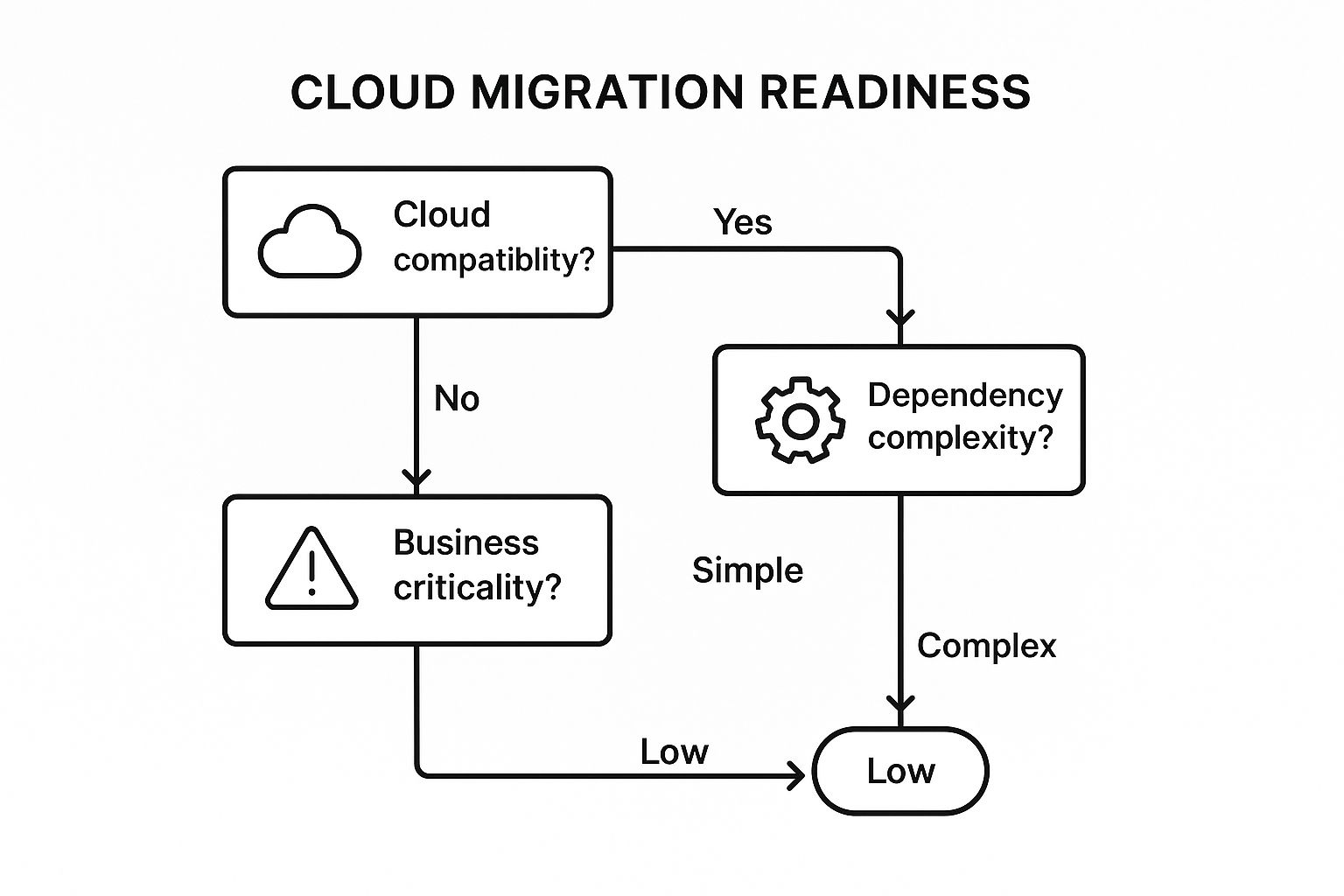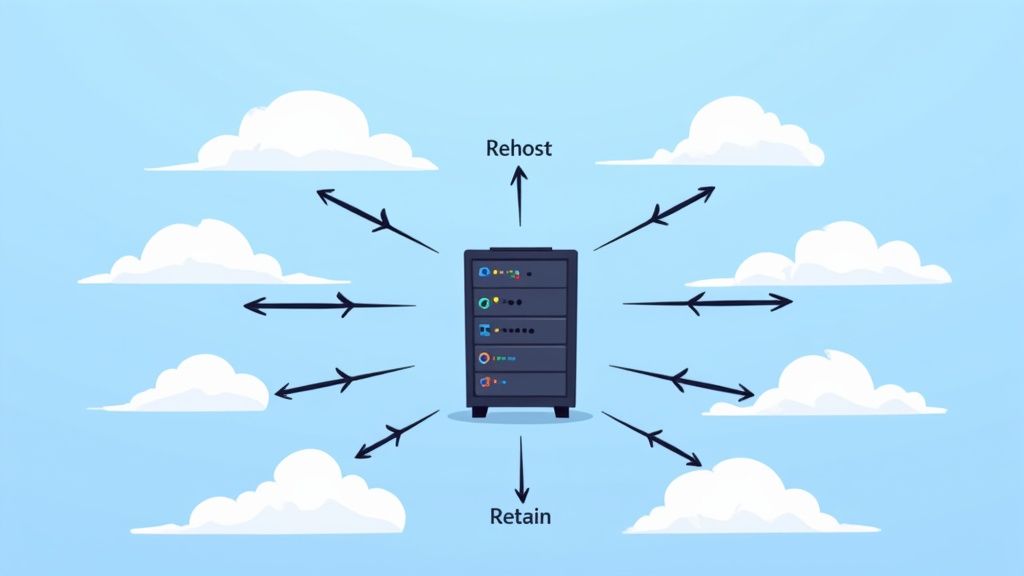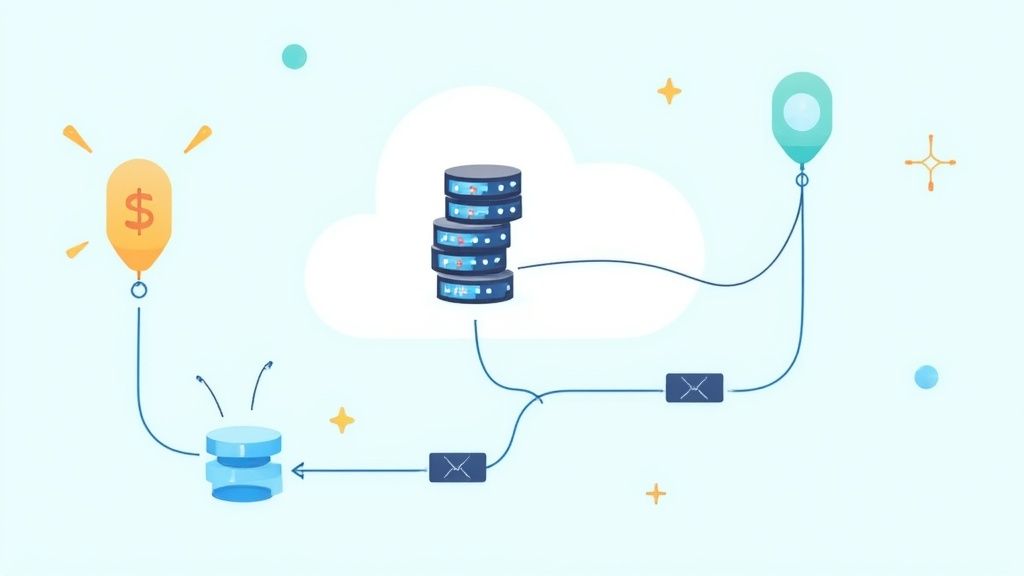Preparing for Cloud Migration Success
Migrating to the cloud presents a powerful opportunity to enhance scalability, resilience, and cost-efficiency. However, a successful cloud migration demands meticulous planning and execution. This cloud migration checklist provides actionable insights to navigate the complexities of moving your infrastructure, applications, and data to the cloud. This list equips you with the tools to minimize disruption, control costs, and maximize your return on investment. Each item offers specific, practical guidance, moving beyond generic advice to provide fresh perspectives on common challenges.
This checklist empowers you to:
- Develop a comprehensive understanding of your existing IT landscape.
- Choose the right migration strategy aligned with your business objectives.
- Establish a robust security and compliance posture in the cloud.
- Optimize cloud costs and prevent unexpected expenses.
- Create a seamless data migration and synchronization plan.
- Design a high-performing and secure network architecture.
- Implement a thorough testing and validation framework.
By following this cloud migration checklist, you'll gain a clear roadmap to a successful cloud transition, mitigating risk and achieving your business goals. We'll cover crucial aspects such as application assessment, strategy selection (using the 6 R's framework), security, cost management, data migration, network design, and testing. This isn't just a list; it's a practical guide to informed decision-making, ensuring your cloud migration is a strategic advantage.
1. Comprehensive Application Assessment and Inventory
A successful cloud migration hinges on understanding your starting point. A comprehensive application assessment and inventory provides this crucial foundation. This process involves meticulously cataloging every application within your current IT environment, mapping their interdependencies, and assessing their technical compatibility with your target cloud platform. This isn't just about knowing what you have, but also understanding how it works and how important it is to your business. This forms the bedrock of your cloud migration checklist.
Why a Thorough Assessment is Essential
Migrating to the cloud without a complete application inventory is like navigating a new city without a map. You're bound to get lost, waste time, and potentially incur unnecessary costs. A thorough assessment allows you to:
- Identify Cloud-Ready Applications: Determine which applications can be easily migrated as-is, which require refactoring, and which are better suited for replacement.
- Prioritize Migration Efforts: Focus on migrating business-critical applications first to minimize disruption and maximize early ROI.
- Optimize Resource Allocation: Accurately estimate the cloud resources needed for each application, avoiding overspending and ensuring optimal performance.
- Mitigate Risks: Identify potential compatibility issues, security vulnerabilities, and performance bottlenecks before they impact your migration.
Real-World Examples
Several industry giants have demonstrated the power of a comprehensive application assessment. Netflix's meticulous pre-migration analysis was instrumental in their successful transition to AWS. Similarly, Capital One's detailed application inventory paved the way for their large-scale cloud transformation. GE's extensive workload analysis during their $3 billion cloud migration underscores the importance of this step for projects of any size.
Actionable Tips for Your Assessment
- Leverage Automated Discovery Tools: Tools like AWS Application Discovery Service and Azure Migrate can automate the process of identifying and cataloging your applications and their dependencies.
- Engage Stakeholders: Involve application owners and business stakeholders early in the assessment process to gain valuable insights into application criticality and dependencies.
- Document Everything: Maintain a detailed inventory of your applications, including technical specifications, dependencies, business impact, and licensing information.
- Prioritize Strategically: Use a prioritization matrix to rank applications based on business criticality and migration complexity.
Using the Application Assessment Decision Tree
The following infographic provides a simplified decision tree to guide your application assessment process. It helps determine the optimal migration path for each application based on cloud compatibility, dependency complexity, and business criticality.

This decision tree guides you through assessing each application's cloud readiness, starting with compatibility. Applications that aren't cloud-compatible might require significant refactoring or replacement. For compatible applications, dependency complexity and business criticality further refine the migration strategy, leading to different approaches like "lift and shift" or phased migrations. This ensures the right strategy for each application.
By incorporating this comprehensive application assessment and inventory into your cloud migration checklist, you gain a clear understanding of your current IT landscape and pave the way for a smoother, more efficient, and ultimately successful cloud migration journey. This crucial first step sets the stage for informed decision-making throughout the entire process.
2. Migration Strategy Selection (6 R's Framework)
A successful cloud migration isn't a one-size-fits-all endeavor. Each application within your IT landscape requires a tailored migration strategy. The 6 R's framework – Rehost, Replatform, Refactor, Repurchase, Retire, and Retain – provides a structured approach to selecting the optimal migration path for each application. This strategic decision significantly impacts the migration's complexity, timeline, and expected benefits, making it a crucial element of your cloud migration checklist.

Why the 6 R's Framework is Essential
Applying the 6 R's framework ensures that each application's migration aligns with your overall business objectives and cloud strategy. It allows you to balance speed, cost, and the long-term benefits of cloud adoption. Without this framework, you risk choosing inappropriate migration strategies, leading to unnecessary complexity, cost overruns, and diminished ROI.
Understanding the 6 R's
- Rehost (Lift and Shift): Migrate applications to the cloud without modification. This offers speed and minimal disruption.
- Replatform: Migrate applications with minor modifications to leverage cloud-native features like managed databases. This balances speed and optimization.
- Refactor: Restructure applications to fully utilize cloud-native services and architecture. This maximizes cloud benefits but increases complexity.
- Repurchase (Replace): Replace existing applications with cloud-based SaaS solutions. This simplifies operations and reduces maintenance.
- Retire: Decommission applications that are no longer needed. This eliminates unnecessary costs and complexity.
- Retain: Keep applications on-premises if cloud migration is not feasible or beneficial. This maintains stability for critical legacy systems.
Real-World Examples of the 6 R's in Action
Coca-Cola's diverse global infrastructure leveraged a hybrid approach, using multiple R's for different applications. Some were rehosted for speed, while others were replatformed to leverage cloud services. Thomson Reuters strategically replatformed its content management systems to improve scalability and performance in the cloud. Airbnb refactored key applications to fully embrace cloud-native architecture, enhancing agility and scalability.
Actionable Tips for Applying the 6 R's
- Start with Rehosting: Identify quick wins and gain cloud experience with minimal initial investment.
- Prioritize Refactoring: Focus refactoring efforts on applications that will significantly benefit from cloud-native features.
- Consider Repurchasing: Explore SaaS solutions for commodity applications to reduce operational overhead.
- Document Your Rationale: Maintain clear documentation for each migration decision to ensure future clarity and maintainability.
Choosing the Right R for Your Applications
The optimal R depends on factors like application complexity, business criticality, and the desired level of cloud integration. Rehosting offers speed, while refactoring maximizes cloud benefits. Retiring or retaining addresses specific application needs, while repurchasing leverages SaaS solutions. This flexible framework helps you create a cloud migration checklist that meets specific needs.
By incorporating the 6 R's framework into your cloud migration checklist, you ensure a strategic approach to application migration. This methodical selection process leads to a more efficient, cost-effective, and successful cloud journey. Each application's migration is optimized for your specific business needs, maximizing the overall impact of your cloud investment.
3. Security and Compliance Framework
A secure and compliant cloud environment isn't a bonus; it's a necessity. Establishing a robust security and compliance framework is paramount for a successful cloud migration. This involves implementing cloud security best practices, maintaining compliance certifications, and establishing governance frameworks. It's about weaving security into the very fabric of your cloud migration checklist, ensuring data protection and regulatory adherence from the outset.

This proactive approach minimizes risks and builds a foundation for long-term security and compliance in the cloud. It's not just about checking boxes; it's about building trust and ensuring business continuity.
Why a Strong Security Posture is Crucial
Migrating to the cloud presents unique security challenges. A well-defined security framework addresses these challenges head-on, protecting your data, your customers, and your reputation. It enables you to:
- Mitigate Security Risks: Identify and address potential vulnerabilities before they can be exploited.
- Maintain Compliance: Adhere to industry regulations and avoid costly penalties.
- Build Customer Trust: Demonstrate your commitment to data security and privacy.
- Ensure Business Continuity: Protect against data loss and disruptions caused by security breaches.
Real-World Examples
Leading organizations prioritize security and compliance in their cloud migrations. JP Morgan Chase implemented zero-trust security during their AWS migration, drastically improving their security posture. FINRA's compliance-first approach to their multi-cloud strategy demonstrates their commitment to regulatory adherence. Philips Healthcare's HIPAA-compliant cloud migration strategy underscores the importance of data privacy in regulated industries.
Actionable Tips for Your Security Framework
- Implement Least-Privilege Access: Grant users only the permissions they need to perform their tasks. This minimizes the potential impact of compromised accounts.
- Use Cloud-Native Security Services: Leverage the security tools and services offered by your cloud provider. These services are often more cost-effective and efficient than managing your own security infrastructure.
- Establish Clear Data Classification and Handling Procedures: Categorize your data based on sensitivity and implement appropriate security controls for each category.
- Regularly Audit and Test Security Controls: Ensure your security controls are functioning as intended and identify any gaps or weaknesses.
Leveraging Industry Best Practices
Frameworks like the Cloud Security Alliance (CSA) guidance, the NIST Cybersecurity Framework, and cloud provider-specific best practices offer valuable resources. They provide a structured approach to building and maintaining a robust security posture in the cloud. These frameworks offer a roadmap to navigate the complexities of cloud security.
By prioritizing security and compliance from the start, you create a secure foundation for your cloud environment. This proactive approach not only protects your business but also fosters trust with your customers. Incorporating a robust security and compliance framework into your cloud migration checklist ensures a smooth and secure transition to the cloud. This protects your valuable data and maintains your reputation for security and trust.
4. Cost Management and Optimization Strategy
A successful cloud migration isn't just about moving your applications; it's about maximizing the value of your cloud investment. Developing a comprehensive cost management and optimization strategy is essential to ensure your cloud spending aligns with your business objectives and delivers the expected ROI. This involves careful planning, continuous monitoring, and proactive optimization throughout the migration lifecycle and beyond. This makes cost management a critical component of any cloud migration checklist.
Why Cost Optimization is Crucial
Cloud costs can quickly spiral out of control without a robust management strategy. Unexpected expenses, inefficient resource utilization, and a lack of visibility can erode the potential benefits of cloud adoption. A well-defined cost optimization strategy allows you to:
- Control Cloud Spending: Establish clear budgets, track actual spending against forecasts, and identify areas for potential savings.
- Maximize Resource Utilization: Ensure you're only paying for the resources you need and that those resources are being used efficiently.
- Improve ROI: Demonstrate the financial value of your cloud migration by minimizing costs and maximizing the return on your investment.
- Enhance Predictability: Gain greater control over your cloud expenses and avoid unexpected surprises.
Real-World Examples
Several organizations have demonstrated the significant impact of effective cloud cost management. Spotify, for instance, implemented automated cost optimization strategies, resulting in a 40% reduction in their cloud spend. Pinterest leveraged spot instances and rightsizing techniques to achieve a 30% cost reduction. Dropbox's strategic use of reserved instances has saved them millions of dollars annually.
Actionable Tips for Cost Optimization
- Implement Cost Monitoring and Alerting: Set up automated monitoring and alerting from the start to proactively identify cost overruns and anomalies.
- Utilize Cloud Provider Tools: Leverage cost management tools provided by your cloud provider, such as AWS Cost Explorer, Azure Cost Management, and Google Cloud Cost Management.
- Explore Third-Party Solutions: Consider using third-party cost management platforms like CloudHealth by VMware for enhanced visibility and control.
- Establish Cost Allocation Tags: Implement tagging policies to track costs by department, project, or application.
- Enforce Governance Policies: Develop and enforce cost governance policies to ensure compliance with budget constraints and best practices.
- Regularly Review and Optimize: Conduct regular reviews of your resource utilization and optimize your cloud environment for maximum efficiency.
Building Your Cost Management Framework
An effective cost management framework should incorporate the following key elements:
- Cost Modeling: Develop accurate cost models to estimate your cloud spending before and during migration.
- Budgeting: Establish clear budgets and track your actual spending against those budgets.
- Monitoring: Implement continuous monitoring of your cloud resources and costs.
- Optimization: Continuously identify and implement cost optimization opportunities.
- Reporting: Generate regular reports to track your progress and identify areas for improvement.
By integrating a comprehensive cost management and optimization strategy into your cloud migration checklist, you gain control over your cloud spending, maximize the value of your cloud investment, and ensure your migration delivers the expected business benefits. This proactive approach sets the stage for long-term financial success in the cloud.
5. Data Migration and Synchronization Plan
A successful cloud migration isn't just about moving applications; it's about moving your data effectively and efficiently. A robust data migration and synchronization plan is paramount for ensuring data integrity, minimizing downtime, and maintaining business continuity throughout the transition. This plan involves selecting appropriate data transfer methods, implementing synchronization mechanisms, and establishing rigorous data validation procedures. This forms a critical part of your cloud migration checklist.

Why a Solid Data Migration Plan is Crucial
Migrating data without a well-defined plan can lead to data loss, corruption, extended downtime, and significant business disruption. A comprehensive data migration plan enables you to:
- Maintain Data Integrity: Ensure that your data remains accurate and consistent throughout the migration process.
- Minimize Downtime: Reduce the impact on business operations by optimizing data transfer and synchronization methods.
- Ensure Business Continuity: Maintain access to critical data and applications during the migration.
- Control Costs: Optimize data transfer and storage costs by selecting the most efficient methods and tools.
Real-World Examples
Several organizations have successfully executed complex data migrations with careful planning. Maersk, a global shipping giant, migrated petabytes of data to Microsoft Azure using a hybrid approach, combining online and offline transfer methods. NASA leveraged AWS Snowball devices to migrate vast amounts of scientific data to the cloud, demonstrating the effectiveness of offline solutions for large datasets. Expedia implemented a real-time data synchronization strategy to ensure seamless business operations during their cloud transformation.
Actionable Tips for Your Data Migration Plan
- Start Early: Data migration can be time-consuming, especially for large datasets. Begin planning and testing early in the migration process.
- Optimize Data Transfer: Use compression and deduplication techniques to reduce data transfer times and costs. Implement parallel transfer streams where possible to further accelerate the process.
- Validate Continuously: Plan for multiple validation checkpoints throughout the migration process to ensure data integrity and identify potential issues early on.
- Choose the Right Tools: Evaluate and select data migration tools that align with your specific needs and the target cloud platform. Tools like AWS DataSync, Azure Data Box, and Google Transfer Service can streamline the process.
Selecting the Right Data Migration Strategy
Choosing the right data migration strategy depends on factors like data volume, downtime tolerance, and network bandwidth. Consider the following approaches:
- Offline Migration: Suitable for large datasets or limited network bandwidth. This involves transferring data using physical devices or offline storage media.
- Online Migration: Best for smaller datasets and applications with higher downtime tolerance. Data is transferred over the network.
- Hybrid Migration: Combines online and offline methods to optimize for different data types and requirements.
By incorporating a robust data migration and synchronization plan into your cloud migration checklist, you ensure the safe and efficient transfer of your valuable data assets. This meticulous planning minimizes disruption and lays the foundation for a successful cloud transformation. This crucial step secures your data and sets the stage for seamless operations in your new cloud environment.
6. Network Architecture and Connectivity Design
A successful cloud migration requires a robust and well-designed network architecture. This involves planning and implementing the network infrastructure necessary to support your cloud operations. It encompasses connectivity between your existing on-premises environment and your chosen cloud platform, ensuring secure data transfer and optimal application performance. Network security and performance optimization are integral to this design process. This aspect is crucial for a smooth and efficient cloud migration checklist.
Why a Well-Designed Network is Crucial
A poorly designed network can cripple your cloud migration, leading to performance bottlenecks, security vulnerabilities, and increased costs. A well-designed network architecture, on the other hand, provides:
- Reliable Connectivity: Ensures consistent and reliable access to your cloud resources, minimizing downtime and disruptions.
- Enhanced Security: Implements robust security measures to protect your data and applications from unauthorized access and cyber threats.
- Optimized Performance: Provides low-latency connectivity and optimized bandwidth allocation for optimal application performance.
- Scalability and Flexibility: Allows your network to scale seamlessly with your growing cloud needs, providing flexibility for future expansion.
Real-World Examples
Several companies have successfully implemented robust network architectures for their cloud migrations. Goldman Sachs leveraged AWS Direct Connect for private connectivity, ensuring secure and high-performance access to their cloud resources. Volkswagen built a global network architecture on AWS to support their IoT platform, enabling seamless data transfer and communication across their global operations. BP implemented a hybrid network design to support their digital transformation, connecting their on-premises systems with their cloud environment.
Actionable Tips for Your Network Design
- Design for Redundancy: Avoid single points of failure by implementing redundant network paths and failover mechanisms. This ensures business continuity in case of outages.
- Implement Network Segmentation: Segment your network based on security requirements, isolating sensitive data and applications from less critical resources.
- Plan for Bandwidth Growth: Anticipate future bandwidth needs and plan for peak usage scenarios to avoid performance bottlenecks as your cloud usage grows.
- Use Cloud-Native Networking Services: Leverage cloud-native networking services, such as virtual private clouds (VPCs), virtual networks, and load balancers, to simplify network management and optimize performance.
Choosing the Right Connectivity Model
Selecting the appropriate connectivity model is critical for ensuring optimal performance and security. Consider factors like bandwidth requirements, security needs, and budget when choosing between options like:
- VPN Connections: Provide secure, encrypted connections over the public internet. Suitable for lower bandwidth requirements and cost-sensitive scenarios.
- Direct Connect/ExpressRoute/Interconnect: Dedicated private connections offering high bandwidth, low latency, and enhanced security. Ideal for mission-critical applications and large data transfers.
- SD-WAN: Software-defined wide area network solutions that offer centralized management and optimization of network traffic. Suitable for complex network environments with multiple locations.
By prioritizing network architecture and connectivity design in your cloud migration checklist, you lay the foundation for a secure, reliable, and high-performing cloud environment. This essential step ensures that your migrated applications operate seamlessly and efficiently, maximizing the benefits of your cloud investment. This preparation contributes significantly to a successful cloud migration journey.
7. Testing and Validation Framework
A successful cloud migration isn't just about moving your applications; it's about ensuring they function seamlessly in the new environment. A robust testing and validation framework is critical to this success. This framework encompasses a suite of testing procedures designed to validate application functionality, performance, and security before, during, and after the migration. This involves functional testing, performance testing, security testing, and user acceptance testing (UAT). This rigorous approach ensures a smooth transition and minimizes disruptions to your business operations.
Why a Thorough Testing Framework is Essential
Testing is the safety net of your cloud migration. It allows you to identify and address potential issues before they impact your users. Without a comprehensive testing plan, you risk encountering unexpected downtime, performance bottlenecks, security vulnerabilities, and user frustration. A well-defined framework provides the following benefits:
- Validate Functionality: Ensure that all applications function as expected in the cloud environment.
- Optimize Performance: Identify and address performance bottlenecks to ensure optimal application responsiveness.
- Enhance Security: Verify that security controls are in place and effective in the new cloud environment.
- Minimize Disruption: Detect and resolve issues early on, minimizing downtime and disruption to business operations.
- Build Confidence: Provide stakeholders with confidence that the migrated applications are ready for production.
Real-World Examples
Leading companies prioritize comprehensive testing in their cloud migrations. Netflix's "chaos engineering" approach, using tools like Chaos Monkey, simulates real-world failures to validate the resilience of their AWS infrastructure. Capital One's rigorous testing framework was instrumental in their successful cloud exit, ensuring a smooth transition back to on-premises infrastructure. Spotify leverages an automated testing pipeline for continuous cloud deployments, enabling rapid releases with minimal risk.
Actionable Tips for Your Testing Framework
- Automate Testing: Automate testing wherever possible, using tools like Selenium or JMeter, to improve efficiency and reduce human error.
- Involve Business Users: Include business users in UAT to validate application functionality from a user perspective.
- Test Disaster Recovery: Test disaster recovery and failover scenarios to ensure business continuity in the event of an outage.
- Document Everything: Document all test results and remediation actions for future reference and auditing.
- Prioritize Test Cases: Focus on high-priority test cases based on application criticality and potential impact.
Types of Testing to Consider
Consider incorporating these key testing types into your framework:
- Functional Testing: Verify that applications perform their intended functions correctly.
- Performance Testing: Assess application performance under various load conditions.
- Security Testing: Identify and mitigate security vulnerabilities.
- User Acceptance Testing (UAT): Validate application functionality from a user perspective.
- Regression Testing: Ensure that changes made during migration haven’t introduced new defects.
By implementing a thorough testing and validation framework within your cloud migration checklist, you significantly reduce the risk of unexpected issues and ensure a smoother, more successful transition. This proactive approach validates application performance, strengthens security, and builds confidence in the migrated environment. This commitment to quality sets the stage for long-term success in the cloud.
7-Point Cloud Migration Checklist Comparison
| Aspect | Comprehensive Application Assessment and Inventory | Migration Strategy Selection (6 R's Framework) | Security and Compliance Framework | Cost Management and Optimization Strategy | Data Migration and Synchronization Plan | Network Architecture and Connectivity Design | Testing and Validation Framework |
|---|---|---|---|---|---|---|---|
| Implementation Complexity 🔄 | High 🔄🔄🔄 – Requires specialized tools and expertise | Medium-High 🔄🔄 – Complex decision-making for large portfolios | High 🔄🔄🔄 – Complex across hybrid environments | Medium 🔄🔄 – Setup and continuous monitoring needed | Medium-High 🔄🔄 – Requires specialized tools and synchronization complexity | High 🔄🔄🔄 – Needs networking expertise and design | Medium-High 🔄🔄 – Multi-phase testing across teams |
| Resource Requirements ⚡ | High ⚡⚡⚡ – Time-intensive and resource-heavy | Medium ⚡⚡ – Multiple skills and tools needed | High ⚡⚡⚡ – Security expertise and ongoing management | Medium ⚡⚡ – Continuous monitoring and adjustment needed | Medium ⚡⚡ – Tools and bandwidth resources required | High ⚡⚡⚡ – Dedicated connections and security appliances | Medium ⚡⚡ – Testing environments and automation resources |
| Expected Outcomes 📊 | Accurate migration readiness, risk reduction 📊📊📊 | Balanced migration strategy optimizing speed, cost, and benefits 📊📊 | Improved security posture and compliance adherence 📊📊📊 | Controlled cloud costs and improved ROI 📊📊 | Data integrity and minimal downtime during migration 📊📊 | Reliable, secure, and scalable network connectivity 📊📊📊 | Validated functionality, performance, and security 📊📊📊 |
| Ideal Use Cases 💡 | Large enterprises with complex app portfolios 💡 | Enterprises needing tailored migration strategies 💡 | Regulated industries and security-sensitive migrations 💡 | Organizations focusing on cost control and optimization 💡 | Data-heavy migrations requiring synchronization 💡 | Businesses requiring hybrid or secure cloud connectivity 💡 | Critical migrations needing robust validation 💡 |
| Key Advantages ⭐ | Prevents surprises, cost estimation, risk reduction ⭐⭐⭐ | Structured, scalable, flexible for diverse apps ⭐⭐ | Reduces risks, maintains compliance, leverages cloud security ⭐⭐⭐ | Prevents cost overruns, transparency, ROI improvement ⭐⭐ | Maintains data integrity, flexibility, minimizes downtime ⭐⭐ | Ensures performance, security, and scalability ⭐⭐⭐ | Identifies issues early, confidence in success ⭐⭐⭐ |
Embracing the Future: Continuous Cloud Optimization
Migrating to the cloud isn't a one-time project; it's an ongoing journey of optimization and adaptation. This cloud migration checklist has provided a comprehensive framework, covering crucial aspects from initial assessment and strategy selection to post-migration validation and optimization. Mastering these concepts empowers your business to leverage the cloud's full potential, driving innovation and achieving long-term success.
Key Takeaways for a Successful Cloud Journey
Let's recap the essential elements of a successful cloud migration strategy:
- Thorough Application Assessment: Understanding your application landscape is the foundation of any successful migration. This involves comprehensive inventory and dependency mapping.
- Strategic Migration Approach: The 6 R's framework provides a structured approach to choosing the right migration strategy for each application, optimizing cost and efficiency.
- Security and Compliance: Implementing robust security measures from the outset is paramount. A well-defined security framework safeguards your data and ensures compliance.
- Cost Optimization: Cloud costs can quickly escalate without proper management. A proactive cost optimization strategy helps you maximize value and control spending.
- Data Migration Planning: A detailed data migration plan ensures data integrity and minimizes downtime during the transition.
- Network Architecture: Designing a robust and scalable network architecture is critical for performance and reliability in the cloud.
- Testing and Validation: Rigorous testing and validation ensure a smooth transition and minimize disruption to business operations.
Optimizing Your Cloud Investment
Your cloud environment isn't static. Business needs evolve, technologies advance, and new opportunities emerge. Continuous optimization is essential for realizing the full value of your cloud investment. Regularly reassess your cloud usage, performance, and costs. Identify areas for improvement and implement changes to enhance efficiency and scalability.
Proactive Monitoring and Adaptation
Proactive monitoring is essential for maintaining a healthy cloud environment. Implement monitoring tools to track performance metrics, identify potential issues, and ensure optimal resource utilization. This allows you to adapt quickly to changing demands and prevent costly downtime.
The Value of Long-Term Planning
Cloud migration is a strategic investment. By embracing a long-term perspective and incorporating continuous optimization into your cloud strategy, you can unlock the cloud's full potential for innovation, growth, and competitive advantage. This proactive approach allows your business to adapt to evolving market dynamics, capitalize on new opportunities, and maintain a strong position in the digital landscape. Remember, a well-executed cloud migration is not just about moving to the cloud; it’s about transforming your business.
Streamline your cloud migration journey and ensure its long-term success with KP Infotech. Our expertise in cloud solutions helps businesses navigate the complexities of cloud migration, from initial planning and implementation to ongoing optimization. Visit KP Infotech to learn how we can help you unlock the full potential of the cloud.
